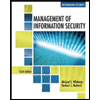7. In many cases, if the IDS detects an intruder, A. Cybersecurity personnel should react swiftly, because the intruder is likely real B. Cybersecurity personnel should react swiftly, even though it's probably a false alarm C. Cybersecurity personnel should wait for more data, because it's probably a false alarm D. Cybersecurity personnel should wait for more data, even though the intruder is likely real
7. In many cases, if the IDS detects an intruder, A. Cybersecurity personnel should react swiftly, because the intruder is likely real B. Cybersecurity personnel should react swiftly, even though it's probably a false alarm C. Cybersecurity personnel should wait for more data, because it's probably a false alarm D. Cybersecurity personnel should wait for more data, even though the intruder is likely real
Management Of Information Security
6th Edition
ISBN:9781337405713
Author:WHITMAN, Michael.
Publisher:WHITMAN, Michael.
Chapter4: Information Security Policy
Section: Chapter Questions
Problem 2E
Related questions
Question

Transcribed Image Text:7. In many cases, if the IDS detects an intruder,
A. Cybersecurity personnel should react swiftly, because the intruder is likely real
B. Cybersecurity personnel should react swiftly, even though it's probably a false alarm
C. Cybersecurity personnel should wait for more data, because it's probably a false alarm
D. Cybersecurity personnel should wait for more data, even though the intruder is likely real

Transcribed Image Text:8. Consider the quantitative version of the risk formula
A. What quantity (dollar value) of risk is generated by a threat that will cause $5,000,000 in
damage if it occurs, and has a 0.1% chance of occurring in any given year?
B. Based on the quantitative risk calculated in part A, is it worth deploying a control that costs
$50,000 per year (easily possible if it requires hiring a dedicated employee)?
C. Consider the case that $5,000,000 in damages is likely to greatly exceed both the total
revenue and the emergency cash reserve of a small business (which typically recommended
to be in the ballpark of 6 months of operating expenses). How would you rate this threat for
such a company, qualitatively?
D. Based on the qualitative risk assessed in part C, is it worth deploying a control that costs
$50,000 per year? Why or why not?
Expert Solution
This question has been solved!
Explore an expertly crafted, step-by-step solution for a thorough understanding of key concepts.
This is a popular solution!
Trending now
This is a popular solution!
Step by step
Solved in 2 steps

Knowledge Booster
Learn more about
Need a deep-dive on the concept behind this application? Look no further. Learn more about this topic, computer-science and related others by exploring similar questions and additional content below.Recommended textbooks for you

Management Of Information Security
Computer Science
ISBN:
9781337405713
Author:
WHITMAN, Michael.
Publisher:
Cengage Learning,

Principles of Information Security (MindTap Cours…
Computer Science
ISBN:
9781337102063
Author:
Michael E. Whitman, Herbert J. Mattord
Publisher:
Cengage Learning

Principles of Information Systems (MindTap Course…
Computer Science
ISBN:
9781305971776
Author:
Ralph Stair, George Reynolds
Publisher:
Cengage Learning

Management Of Information Security
Computer Science
ISBN:
9781337405713
Author:
WHITMAN, Michael.
Publisher:
Cengage Learning,

Principles of Information Security (MindTap Cours…
Computer Science
ISBN:
9781337102063
Author:
Michael E. Whitman, Herbert J. Mattord
Publisher:
Cengage Learning

Principles of Information Systems (MindTap Course…
Computer Science
ISBN:
9781305971776
Author:
Ralph Stair, George Reynolds
Publisher:
Cengage Learning

Fundamentals of Information Systems
Computer Science
ISBN:
9781337097536
Author:
Ralph Stair, George Reynolds
Publisher:
Cengage Learning

Principles of Information Systems (MindTap Course…
Computer Science
ISBN:
9781285867168
Author:
Ralph Stair, George Reynolds
Publisher:
Cengage Learning